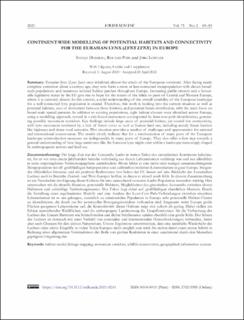| dc.contributor.author | Dobbert, Svenja | |
| dc.contributor.author | Pape, Roland | |
| dc.contributor.author | Löffler, Jörg | |
| dc.date.accessioned | 2022-03-07T12:41:34Z | |
| dc.date.available | 2022-03-07T12:41:34Z | |
| dc.date.created | 2022-01-26T18:36:52Z | |
| dc.date.issued | 2021 | |
| dc.identifier.citation | Dobbert, S., Pape, R., & Loffer, J. (2021). Dobbert, S., Pape, R., & Loffer, J. (2021). Continent-Wide Modelling of Potential Habitats and Connectivity for the Eurasian Lynx (Lynx lynx) in Europe. Erdkunde, 75(2), 69-85. | en_US |
| dc.identifier.issn | 0014-0015 | |
| dc.identifier.uri | https://hdl.handle.net/11250/2983423 | |
| dc.description.abstract | Eurasian lynx (Lynx lynx) once inhabited almost the whole of the European continent. After facing nearly complete extinction about a century ago, they now form a more or less connected metapopulation with eleven broad-scale populations and numerous isolated habitat patches throughout Europe. Increasing public interest and a favourable legislative status by the EU give rise to hope for the return of the felide to parts of Central and Western Europe, where it is currently absent. In this context, a solid understanding of the overall suitability of the European landscape for a well-connected lynx population is crucial. Therefore, this work is looking into the current situation as well as potential habitats, ease of movement between those habitats, and potential future distribution, with the main focus on broad-scale spatial patterns. In addition to existing populations, eight habitat clusters were identified across Europe, using a modelling approach, rooted in a rule-based assessment accompanied by least-cost path identification, generating possible movement corridors. Key findings include large areas of potential habitat, yet overall low connectivity, with lynx movement restricted by a lack of forest cover as well as human land use, including mainly linear barriers like highways and dense road networks. This situation provides a number of challenges and opportunities for national and international conservation: The results clearly indicate that for a recolonisation of many parts of the European landscape reintroduction measures are indispensable in many parts of Europe. They also offer a first step towards a general understanding of how large carnivores like the Eurasian lynx might exist within a landscape increasingly shaped by anthropogenic actions and land use. | en_US |
| dc.language.iso | eng | en_US |
| dc.rights | Navngivelse 4.0 Internasjonal | * |
| dc.rights.uri | http://creativecommons.org/licenses/by/4.0/deed.no | * |
| dc.title | Continent-Wide Modelling of Potential Habitats and Connectivity for the Eurasian Lynx (Lynx lynx) in Europe | en_US |
| dc.type | Journal article | en_US |
| dc.type | Peer reviewed | en_US |
| dc.description.version | publishedVersion | en_US |
| dc.rights.holder | © Uni Bonn. | en_US |
| dc.source.pagenumber | 69-85 | en_US |
| dc.source.volume | 75 | en_US |
| dc.source.journal | Erdkunde | en_US |
| dc.source.issue | 2 | en_US |
| dc.identifier.doi | https://doi.org/10.3112/erdkunde.2021.02.01 | |
| dc.identifier.cristin | 1990749 | |
| cristin.ispublished | true | |
| cristin.fulltext | original | |
| cristin.qualitycode | 1 | |

